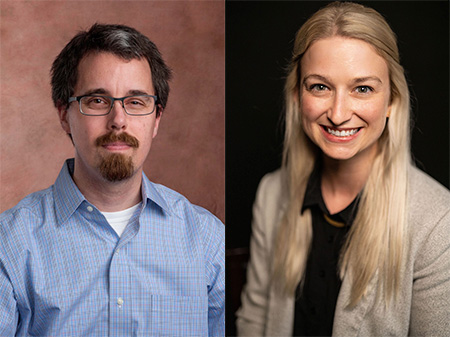
The medical school has received a two-year award from the CDC Foundation that will fund a project aimed at revolutionizing the management of medicolegal death investigation data and combating the opioid epidemic in Michigan and nationwide.
The Medicolegal Death Investigation Novel Data Modernization Initiatives RFI award, which totals $232,000, was announced by the CDC Foundation in September and the funding runs through September 2025.
The award to WMed will fund “Data-Driven Solutions: Transforming MDI with Synoptic Autopsy Reporting,” a research project that is being led by Patrick Hansma, DO, and Anna Tart, MD, who both serve as assistant professors in the medical school’s Department of Pathology.
Drs. Hansma and Tart and their research team, which also includes Abigail Grande, MPH, and project coordinator Rachel Martindale, PA (ASCP), are attempting to create a synoptic autopsy report system within MDILog, a case management system that is used by forensic pathologists and medical examiners across the U.S., including the Office of the Medical Examiner and Forensic Services in Kalamazoo. Drs. Hansma and Tart, and other faculty within the Department of Pathology provide forensic pathology services to Kalamazoo and 11 other Michigan counties through their work in the Office of the Medical Examiner and Forensic Services, which is housed at the medical school’s W.E. Upjohn M.D. Campus.
Dr. Hansma said the creation of the new autopsy report system, which is now underway, aims to streamline data entry, improve data quality, and enhance information sharing in death investigations. If successful, the system would equip forensic pathologists and medical examiners with resources to generate accurate and comprehensive reports and allow for a more effective response to the opioid epidemic.
“As a ME office, we are intimately involved in the opioid crisis and our understanding of the crisis and our response to it is tied to our ability to mine data around fatalities,” Dr. Hansma said. “Through this project, we hope to create a tool that will allow us to quickly gather the most robust data we can in death investigations, especially those involving opioids.”
Grande, who serves as Senior Manager for Research and Autopsy Operations in the Department of Pathology, said synoptic autopsy reports are already used regularly in hospitals for surgical pathology cases. Now, Grande, who is serving as the project’s senior manager, said the reports can serve as a tool for the Office of the Medical Examiner and Forensic Services, and potentially other medical examiner offices, to improve data quality and consistency in death investigations and allow for quicker analysis and reporting out to stakeholders such as county health departments, county commissioners, and law enforcement officials.
“The ME’s office is a public health office and I believe in the philosophy that forensic pathology is actually the practice of preventive medicine,” Dr. Hansma said. “Each autopsy we do is gathering data from someone we can no longer help. However, we can still serve our citizenry in the best way possible by looking at health threats and capturing what those are through accurate and expedient data analysis.”
That quick analysis of data, Dr. Hansma said, will help identify trends and risk factors and equip researchers and policymakers with the information they need to address the opioid epidemic through prevention and response strategies that are evidence based.
Moving forward, Dr. Hansma said the design and development of the autopsy report system will take place in the first half of 2024 with the goal of pilot implementation and testing in the second half of the new year. Full implementation is planned for late 2024 and the first half of 2025.
“We’ve conceived the idea, now we’ll begin building it,” Dr. Hansma said. “The implementation will begin in the second year and then we will have the retrospect to see if the system actually accomplishes what we hope it will.”
